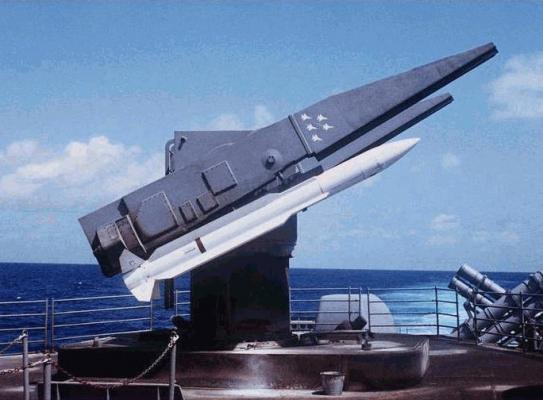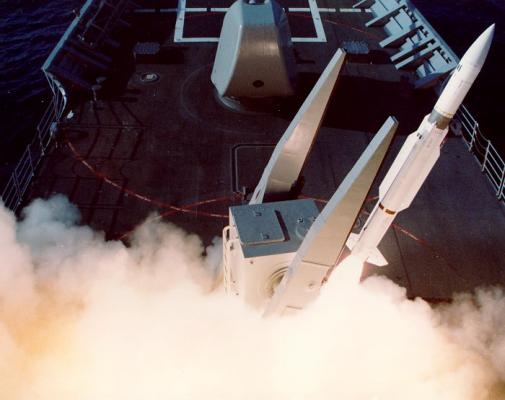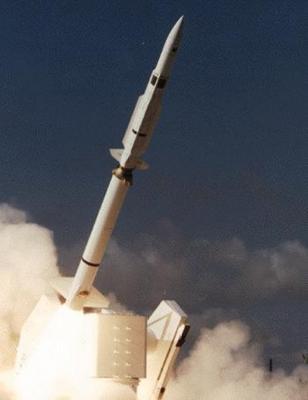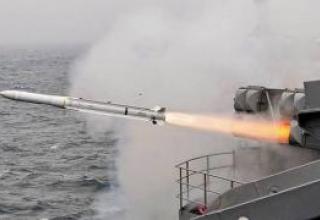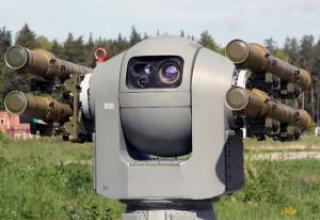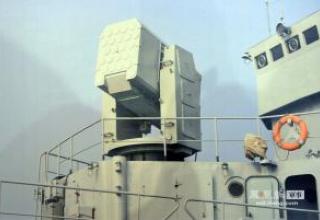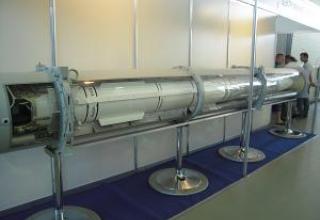American rockets "Standard" is a family of solid-propellant antiaircraft guided missiles class "ship - air", designed to protect ships from air strikes at medium (20 to 100 km) and long (over 100 km) ranges. At present, they are part of the ship's anti-aircraft missile systems (SAMs) Aegis, Tartar and Terrier.
In addition, on the basis of these SAMs, several modifications of anti-ship (ship-to-ship class) and anti-radar ("air-to-surface") guided missiles with the same name have been created.
The development of the "Standard" SAMs began in 1964 with the aim of reducing the large number of obsolete anti-aircraft missiles in service with the U.S. Navy at the time, and standardizing medium- and long-range ship-based anti-aircraft missile weapons. These were designed to minimize the use of new elements in the control systems of the then-existing SAM systems, the existing launchers, and the ship's storage and reloading systems.
The missile was designed in two versions:
- Medium Range - MR (Medium Range) to replace the Tartar SAM (RIM-24),
- Extended Range - ER (Extended Range) to replace the Terrier ASD. (RIM-2) and "Talos" (RIM-8).
Composition:
All "Standard" missiles are made according to the normal aerodynamic scheme and have a modular design On the middle part of their hull are attached four X-shaped wings of small elongation, almost reaching the folding aerodynamic rudders of a large area in the tail of the LSD. The ZUR with extended range is additionally equipped with solid fuel starting accelerators with X-shaped four-plane stabilizer. The boosters are connected to the missiles by a special cylindrical transition unit.
Structurally, the SAMs of the "Standard" family consist of five main compartments: the head, combat unit (BC), autopilot, engine and tail.
The head compartment is covered with a radio-transparent plastic oval-shaped fairing. It accommodates a homing radar head, signal processing unit, radio detonator and on-board computer. The CNS provides target search, tracking and homing of the missile. The SAM flight control is performed with the help of computer, inertial guidance unit and autopilot.
The compartment of the combat unit accommodates a fragmentation fragmentation-phase or rod type BC, which is detonated by a radar fuse (several missile versions also use a contact impact fuse). For safe operation, the combat unit is coupled with a safety mechanism that has four degrees of protection.
The autopilot compartment contains an autopilot unit, a voltage converter and an electric battery.
The engine compartment is equipped with a single-chamber solid fuel motor (has several modifications).
In the tail compartment there is a motor nozzle and electric drives for aerodynamic steering wheel control.
Assembly and testing of fully assembled missiles are carried out in the Navy's arsenals, which receives their individual components from manufacturers. They are then stockpiled or transferred to the ship. If any malfunction or failure is detected, the SAMs are returned for inspection and repair.
Standard-1MR SAM.
The Standard-1MR (RIM-66) air defense guided missile is the base missile of the Standard family of air defense systems.
Various foreign editions are characterized by their own ways of designating models and modifications of missiles "Standard-1MR". In particular, the following variants can be equally applied: RIM-66B1, or RIM-66 Block 1B, or RIM-66B Block 1, or RIM-66B mod.1. It is not obligatory to use a number to denote mod.0.
By its appearance and mass dimensional characteristics of the rocket is similar to the previous ZUR - "Tartar", but has the following features: radio electronic equipment is made on miniature modular schemes, hydraulic power steering wheel drives are replaced by electric, used a new power source (dry silver-zinc storage battery disposable).
Production of the first "Standard" missiles known as "Standard-1" or "Standard SM-1" began in 1967 and continued for 20 years until 1987.
Onboard equipment in these RSDs was, for the first time, powered by solid-state elements and their aerodynamic rudders were driven by electric drives (previously, hydraulic drives were used for this purpose). In contrast to the old rockets, the preparation of "Standard" LSDs for launch takes less than 1 s, as long (5-7 minutes) heating of the equipment is not needed. In addition, during the development of new RSDs, they have been improved so that there is no need to maintain the missiles when stored on a ship for a long time. This, in turn, made it possible to exclude from the composition of SAMs numerous control and measuring equipment, which was previously used to maintain missiles in a combat-ready state.
Standart-1" (RIM-66A) SAM is aimed at the target of semi-active radar CNS with conical scanning of the antenna beam. As the propulsion system it uses a dual-mode marching engine Mk27 mod.0 firm "Aerodget". Its starting and marching solid fuel charges are located concentrically. To the body of the combustion chamber the marching charge (in the form of a cylindrical tube) is tightly attached, inside which the starting charge is placed.
The missile is equipped with the Mk51 rotor-type combat unit weighing 60 kg (BB 30 kg). It is detonated by means of contact and remote fuses. This BC contains 400 rods and has a kill radius of up to 15m. At present, the RIM-66A SAM is no longer in service with the US Navy.
Anti-aircraft guided missile "Standard-1MR" (RIM-66B) in appearance and dimensions similar to the RIM-66A, but differs from it somewhat larger mass, increased range and improved guidance system. The range of the RIM-66B has been increased by the use of the new Mk56 engine (manufactured by Hercules). In starting mode (fuel weight is about 130 kg) it works 4 s and produces a thrust up to 8500 kgf, and in marching mode (almost 150 kg) - about 30 s with a thrust of about 1600 kgf.
Specialists of General Dynamics have developed six modifications of RIM-66B. They differ from each other by design of these or those elements, and in modifications from the first to the fourth (mod.1 - 4), these differences are insignificant and are mainly related to the improvement of electronic and anti-interference systems.
The first three modifications (mod.1, 2 and 3) were used only during the missile development process, so in 1967 the U.S. Navy received the "Standard-1MR" (RIM-66B) mod.4 SAM system. However, in 1968, its production was discontinued, and from 1969 to 1974 the missile mod.5 was produced, which is currently in service with the U.S. Navy and other Western countries.
In contrast to the previous modifications, the Mk51 rockets are replaced by the Mk90 shrapnel-type combat unit instead of the Mk56 engine, and the Mk27 (made by Aerodet) instead of the Mk56 engine, which provides long range and altitude of targets.
In the last modification of this RMS (mod.6) the homing head with conical scanning was replaced by a monopulse SOS, and the analogue on-board computer - by a digital one. Nevertheless, in 1985, the production of RIM-66V mod.6 missiles was discontinued due to the adoption of a new generation of SAMs for service with the Navy.
SAM "Standard-1ЕR".
Anti-aircraft guided missile "Standard-1ER" (RIM-67A) by its appearance of mass and dimensional characteristics similar to the ZUR "Terrier" It is a two-stage solid fuel missile, the first stage of which is a launch accelerator Mk12 (firm "Hercules"), The second stage of RIM-67A is designed in the same way as for RIM-66B mod. 5, however it is equipped by other marching single-mode engine.
In total, two models of these missiles have been developed, the main difference of which is the use of different marching engines firm ARC in the first model is used Mk20, and in the second (mod. 2) - more economical Mk30.
Production of "Standard-1ER" SAMs was discontinued in 1973, and now they are removed from service with the U.S. Navy ships.
Characteristics:
| SM-1MR | SM-1ER | |
| Length, m | 4.41 | 7.98 |
| Diameter,m | 0.343 | 0.343 |
| Wingspan, m | 1,08 | 1.57 |
| Start weight, kg | 642.3 | 1343.6 |
| Start range, km | 27,8-37,1 | 64.0 |
Testing:
Among the various types of medium- and long-range anti-aircraft missiles in the arsenal of the U.S. Navy and other states, "Standard" SAMs are the most widely used. In total, the leading designers of these missiles (the U.S. companies General Dynamics and Reitheon) supplied customers (Australia, Canada, France, Germany, Iran, Israel, Italy, Japan, the Netherlands, the Republic of Korea and Spain) with about 14,000 "Standard" SAM systems of various models and modifications designed for deployment on 156 ships.
Sources:
- Зенитные ракетные комплексы ПВО СВ. Техника и вооружения №5-6.99
